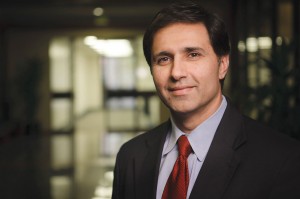The FDA approves USC-developed ‘bionic eye’ system
Hailed as the “bionic eye,” a retinal prosthesis system developed at USC has brought acclaim and attention after receiving approval from the Food and Drug Administration last week. The retinal prosthesis system can restore partial vision to blind people suffering from certain degenerative eye diseases.

New vision · Marl Humayun, a retinal surgeon, biomedical engineer and professor at USC, is the principal architect behind the project. — Mark Berndt | Daily Trojan
Mark Humayun, a professor of ophthalmology, biomedical engineering, cell and neurobiology at the Keck School of Medicine of USC, was the principal developer of the system (dubbed Argus II), investing the past 25 years in the project. The idea came about when he began thinking of ways to help his grandmother, who was blind, because the approaches in medicine were of little help at the time. Later, he witnessed a procedure in which a patient saw a flash of color in response to electrical stimulation of the portion of the brain that controls vision.
“People around the world have called it the ‘bionic eye,’ but a better term would be an artificial retina, something that stimulates the remaining cells in the retina to send the information by the optic nerve,” said Humayun, who is also a retinal surgeon and biomedical engineer.
The system was approved to help treat patients afflicted with retinitis pigmentosa. Retinitis pigmentosa, an inherited condition that affects about 100,000 people in the United States, damages the light-sensing rod and cone cells in the retina, causing degeneration of vision and blindness.
Humayun said the condition usually begins with night blindness followed by loss of peripheral vision and then complete loss of vision, which usually occurs in the patient’s 50s or 60s. Only a small percentage of those affected with the condition lose their vision entirely, which is why the Argus II was approved as a Humanitarian Use Device, a designation given when less than 4,000 patients are expected to be treated per year.
The system — named after Argus, the giant in Greek mythology with 100 eyes — is manufactured by Second Sight Medical Products. It essentially replaces the damaged retina with a system of electrodes. These electrodes can interpret images sent by a camera mounted on a pair of glasses worn by the user.
“It encodes the information from the camera into neural code so the remaining cells can safely understand it and send it via the optic nerve to the brain, so the brain can understand it,” Humayun said. “We have to basically jumpstart the otherwise blind eye.”
The results have been astonishing. Patients using the Argus II can “see” a grayscale field that allows them to distinguish contours and perceive depth. Patients have experienced dramatic improvement in vision, including being able to read small letters held in their palm, make out chairs and tables and notice curbs and step over them.
“The exciting thing is being able to do things they haven’t been able to do in a long time,” Humayun said. “One of my patients was able to see the Fourth of July fireworks for the first time. Being able to see lights on a Christmas tree — things we take for granted — they haven’t been able to do for 30 years.”
Initial testing began in 1992 and Humayun placed the first implantable system, Argus I, with 16 electrodes, in a human patient in 2002 at USC. Humayun implanted the Argus II, with 60 electrodes, in the first U.S. patient in 2007. In 2011 it was approved as a medical device in Europe, and finally, this year, in the United States.
Humayun said the development was largely a collaborative effort involving 30 faculty members from 20 institutions in both the United States and abroad, several national laboratories and over 200 students over the years. The initial key players were fellow professor James Weiland and former graduate student Rob Greenberg, who became the CEO of Second Sight Medical Products.
“This is definitely not a one-man show,” Humayun said. “Something like this requires a lot of synergy and a large team effort.”
Humayun said his role has evolved from initially doing almost everything, from research to engineering, to primarily guiding and teaching. He has traveled extensively, training surgeons on how to implant the Argus device.
Looking ahead, Humayun said they are hoping, among other things, to improve the digital software for the device to give patients better quality of vision. Additionally, Second Sight is looking to develop a device that can be implanted directly in the brain for patients whose retinas have degenerated completely.
“This is just the tip of the iceberg,” Humayun said. “This technology is just starting.”
